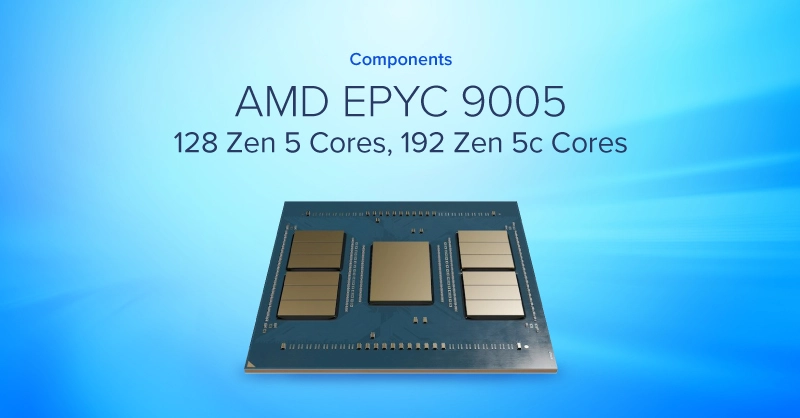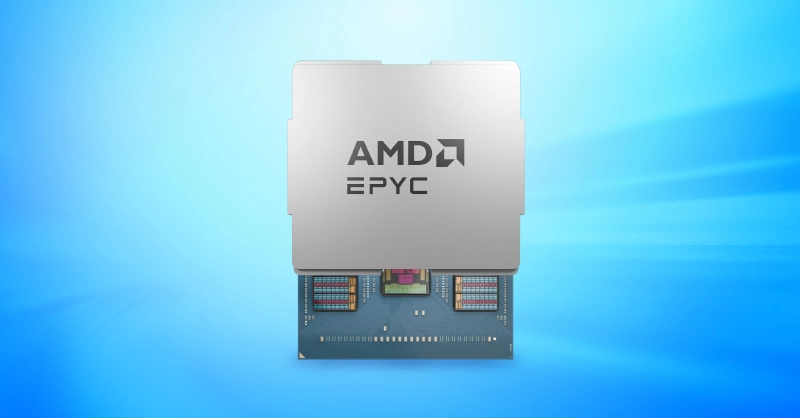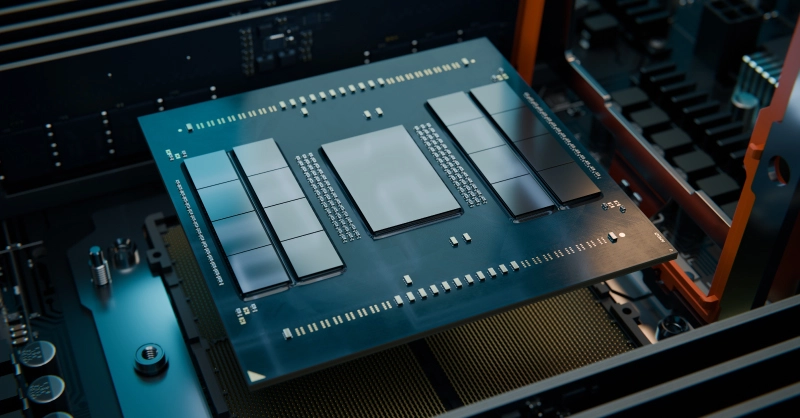
Introduction
AMD EPYC 9005, code-named Turin, launched on October 10, 2025, showcases dedication to driving innovation in the data center. AMD continues its growth as the preferred processor of choice for hyperscalers and cloud service providers.
AMD EPYC 9005 features an updated architecture built on the same SP5 socket platform featuring up to 192 Cores and 384 threads on the Zen 5c-based processor and up to 128 cores and 265 threads on the using the Zen 5-based processor. The newest generation of powerful and efficient AMD EPYC 9005 aims to better meet the needs of various data center workloads. With its release, Exxact Corporation will detail the specifications and the use cases of AMD EPYC and how your data center can be transformed.

AMD EPYC 9005 - Zen 5 & Zen 5c Advancements
5th Gen AMD EPYC 9005 releases with 2 core types right out of the gate. Zen 5 is AMD’s traditional core architecture used for general-purpose computing and HPC workloads built on the TSMC 4NM process. Zen 5C is AMD’s density-focused core architecture built on TSMC 3NM, a smaller process node that enables increased total core count.
Instructions Per Clock Uplift
AMD’s Zen 5 architecture first debuted in its consumer Ryzen 9000 series processors. With a 16% improvement in IPC compared to Zen 4, we can expect huge productivity gains for AMD EPYC 9005, especially when leveraging these processors at full tilt.
Zen 5’s IPC improvement is attributed to a wider front end paired with a larger integer execute engine that supports additional instructions run per clock cycle. Boosted ALUs and a unified scheduler improve efficiency and speed, while additional L1 cache reduces memory penalties.
Zen 5c Has the Same Cache
Unlike the last generation, when Zen 4 and Zen 4c had differing parts (9004 Genoa & 8004 Bergamo), Zen 5c will be included in the Turin naming convention because the core architecture is not drastically different this time around. The Zen 5c architecture will not have cut down clock speeds and will have increased density due to that smaller TSMC 3NM process. Zen 5c EPYC processors will peak at 192 cores and 384 threads.
Chiplet Architecture Changed
While the implementation of AMD EPYC using a chiplet-based technology has not changed, the layout in EPYC 9005 differs from EPYC 9004. Instead of 4 quadrants of rows, Zen 5 and Zen 5c utilize 4 columns with up to 4 CCDs per column. While the area of each CCD has not changed, the more square-shaped CCDs and column layout allow AMD to cram more silicon on the substrate, increasing the core count to up to 16 CCDs on a single processor.

EPYC 9005 Processor Specifications
With all these minor yet innovative changes to the processor silicon and layout, here is the initial release SKU stack for AMD EPYC 9005. Specifications are subject to change. Upon shipping, Exxact will offer AMD EPYC 9005 server solutions for all workload types.
AMD EPYC 9005 is built on the same SP5 socket as the last generation and serves as drop-in replacement for EPYC 9004 deployments. All AMD EPYC 9005 processors feature/support:
- 12 channels of DDR5 ECC Memory at 6000 MT/s
- PCIe Gen 5 lanes
- 128 lanes in single CPU configurations
- 160 lanes in dual CPU configurations
- AVX-512 Instruction Set
- CXL 2.0 capabilities supporting Type 1 & Type 3
- Type 1: memory coherent devices that share memory with the CPU such as PGAs, GPUs, and NICs that can take advantage of fast memory access to the CPU.
- Type 3: memory expansion devices that increase system memory like additional RAM capacity.
- P suffix on processor models is single socket only.
- F suffix on processor models signify frequency-optimized processors.
CPU | Core Type | Cores/Threads | Base Clock | Boost Clock | L3 Cache | TDP |
|---|---|---|---|---|---|---|
| EPYC 9965 | Zen 5c | 192C / 384T | 2.25 GHz | 3.70 GHz | 384MB | 500W |
| EPYC 9845 | Zen 5c | 160C / 320T | 2.10 GHz | 3.70 GHz | 320MB | 390W |
| EPYC 9825 | Zen 5c | 144C / 288T | 2.20 GHz | 3.70 GHz | 384MB | 390W |
| EPYC 9755 | Zen 5 | 128C / 256T | 2.70 GHz | 4.10 GHz | 512MB | 500W |
| EPYC 9745 | Zen 5c | 128C / 256T | 2.40 GHz | 3.70 GHz | 256MB | 400W |
| EPYC 9655 | Zen 5 | 96C / 192T | 2.60 GHz | 4.50 GHz | 384MB | 400W |
| EPYC 9655P | Zen 5 | 96C / 192T | 2.60 GHz | 4.50 GHz | 384MB | 400W |
| EPYC 9645 | Zen 5c | 96C / 192T | 2.30 GHz | 3.70 GHz | 384MB | 320W |
| EPYC 9565 | Zen 5 | 72C / 144T | 2.30 GHz | 4.30 GHz | 384MB | 400W |
| EPYC 9575F | Zen 5 | 64C / 128T | 3.15 GHz | 5.00 GHz | 256MB | 400W |
| EPYC 9555 | Zen 5 | 64C / 128T | 3.30 GHz | 4.40 GHz | 256MB | 360W |
| EPYC 9555P | Zen 5 | 64C / 128T | 3.20 GHz | 4.40 GHz | 256MB | 360W |
| EPYC 9535 | Zen 5 | 64C / 128T | 2.40 GHz | 4.30 GHz | 256MB | 300W |
| EPYC 9475F | Zen 5 | 48C / 96T | 3.65 GHz | 4.80 GHz | 256MB | 400W |
| EPYC 9455 | Zen 5 | 48C / 96T | 3.15 GHz | 4.40 GHz | 192MB | 300W |
| EPYC 9455P | Zen 5 | 48C / 96T | 3.15 GHz | 4.40 GHz | 192MB | 300W |
| EPYC 9365 | Zen 5 | 36C / 72T | 3.40 GHz | 4.30 GHz | 192MB | 300W |
| EPYC 9375F | Zen 5 | 32C / 64T | 3.80 GHz | 4.80 GHz | 256MB | 320W |
| EPYC 9355 | Zen 5 | 32C / 64T | 3.55 GHz | 4.40 GHz | 256MB | 280W |
| EPYC 9355P | Zen 5 | 32C / 64T | 3.55 GHz | 4.40 GHz | 256MB | 280W |
| EPYC 9335 | Zen 5 | 32C / 64T | 3.00 GHz | 4.40 GHz | 256MB | 210W |
| EPYC 9275F | Zen 5 | 24C / 48T | 4.10 GHz | 4.80 GHz | 256MB | 320W |
| EPYC 9255 | Zen 5 | 24C / 48T | 3.20 GHz | 4.30 GHz | 128MB | 200W |
| EPYC 9175F | Zen 5 | 16C / 32T | 4.20 GHz | 5.00 GHz | 512MB | 320W |
| EPYC 9135 | Zen 5 | 16C / 32T | 3.65 GHz | 4.30 GHz | 64MB | 200W |
| EPYC 9115 | Zen 5 | 16C / 32T | 2.60 GHz | 4.10 GHz | 64MB | 125W |
| EPYC 9015 | Zen 5 | 8C/ 16T | 3.60 GHz | 4.10 GHz | 64MB | 125W |
AMD EPYC 9005 Key Takeaways
AMD EPYC 9005 is on the same platform as last generation AMD EPYC 9004 and has a plethora of changes under the hood. AMD EPYC 9005 was able to deliver increased performance that was already a recognized top-tier processor offering exceptional performance and higher per-processor density.
AMD increased the total core count on their top-of-line 128-core Zen 4c to 196 cores of Zen 5c and increased the total core count of the top-of-line 96-core Zen 4 to 128 cores of Zen 5. The increased density in both the mainstream performance part and the efficiency optimized part enables data centers to consolidate their servers to new levels increasing performance and reducing the total cost of ownership. AMD EPYC 9005 also features processors reaching 5.0GHz of turbo clock speed, perfect for frequency-optimized workloads.
Data centers with varying workloads can take advantage of AMD EPYC at any level; core density is optimal for hyperscaler and cloud VM workloads, core performance and density are optimal for HPC and AI workloads that require the best of both worlds, and frequency-optimized EPYC is optimal for HPC workloads that have stringent per-core licenses.
Exxact will feature AMD EPYC 9005 in our various server platforms for running machine learning and AI, HPC simulation workloads, life science and molecular dynamics, and more.

AMD EPYC 9005 - 128 Zen 5 Cores, 192 Zen 5c Cores
Introduction
AMD EPYC 9005, code-named Turin, launched on October 10, 2025, showcases dedication to driving innovation in the data center. AMD continues its growth as the preferred processor of choice for hyperscalers and cloud service providers.
AMD EPYC 9005 features an updated architecture built on the same SP5 socket platform featuring up to 192 Cores and 384 threads on the Zen 5c-based processor and up to 128 cores and 265 threads on the using the Zen 5-based processor. The newest generation of powerful and efficient AMD EPYC 9005 aims to better meet the needs of various data center workloads. With its release, Exxact Corporation will detail the specifications and the use cases of AMD EPYC and how your data center can be transformed.

AMD EPYC 9005 - Zen 5 & Zen 5c Advancements
5th Gen AMD EPYC 9005 releases with 2 core types right out of the gate. Zen 5 is AMD’s traditional core architecture used for general-purpose computing and HPC workloads built on the TSMC 4NM process. Zen 5C is AMD’s density-focused core architecture built on TSMC 3NM, a smaller process node that enables increased total core count.
Instructions Per Clock Uplift
AMD’s Zen 5 architecture first debuted in its consumer Ryzen 9000 series processors. With a 16% improvement in IPC compared to Zen 4, we can expect huge productivity gains for AMD EPYC 9005, especially when leveraging these processors at full tilt.
Zen 5’s IPC improvement is attributed to a wider front end paired with a larger integer execute engine that supports additional instructions run per clock cycle. Boosted ALUs and a unified scheduler improve efficiency and speed, while additional L1 cache reduces memory penalties.
Zen 5c Has the Same Cache
Unlike the last generation, when Zen 4 and Zen 4c had differing parts (9004 Genoa & 8004 Bergamo), Zen 5c will be included in the Turin naming convention because the core architecture is not drastically different this time around. The Zen 5c architecture will not have cut down clock speeds and will have increased density due to that smaller TSMC 3NM process. Zen 5c EPYC processors will peak at 192 cores and 384 threads.
Chiplet Architecture Changed
While the implementation of AMD EPYC using a chiplet-based technology has not changed, the layout in EPYC 9005 differs from EPYC 9004. Instead of 4 quadrants of rows, Zen 5 and Zen 5c utilize 4 columns with up to 4 CCDs per column. While the area of each CCD has not changed, the more square-shaped CCDs and column layout allow AMD to cram more silicon on the substrate, increasing the core count to up to 16 CCDs on a single processor.

EPYC 9005 Processor Specifications
With all these minor yet innovative changes to the processor silicon and layout, here is the initial release SKU stack for AMD EPYC 9005. Specifications are subject to change. Upon shipping, Exxact will offer AMD EPYC 9005 server solutions for all workload types.
AMD EPYC 9005 is built on the same SP5 socket as the last generation and serves as drop-in replacement for EPYC 9004 deployments. All AMD EPYC 9005 processors feature/support:
- 12 channels of DDR5 ECC Memory at 6000 MT/s
- PCIe Gen 5 lanes
- 128 lanes in single CPU configurations
- 160 lanes in dual CPU configurations
- AVX-512 Instruction Set
- CXL 2.0 capabilities supporting Type 1 & Type 3
- Type 1: memory coherent devices that share memory with the CPU such as PGAs, GPUs, and NICs that can take advantage of fast memory access to the CPU.
- Type 3: memory expansion devices that increase system memory like additional RAM capacity.
- P suffix on processor models is single socket only.
- F suffix on processor models signify frequency-optimized processors.
CPU | Core Type | Cores/Threads | Base Clock | Boost Clock | L3 Cache | TDP |
|---|---|---|---|---|---|---|
| EPYC 9965 | Zen 5c | 192C / 384T | 2.25 GHz | 3.70 GHz | 384MB | 500W |
| EPYC 9845 | Zen 5c | 160C / 320T | 2.10 GHz | 3.70 GHz | 320MB | 390W |
| EPYC 9825 | Zen 5c | 144C / 288T | 2.20 GHz | 3.70 GHz | 384MB | 390W |
| EPYC 9755 | Zen 5 | 128C / 256T | 2.70 GHz | 4.10 GHz | 512MB | 500W |
| EPYC 9745 | Zen 5c | 128C / 256T | 2.40 GHz | 3.70 GHz | 256MB | 400W |
| EPYC 9655 | Zen 5 | 96C / 192T | 2.60 GHz | 4.50 GHz | 384MB | 400W |
| EPYC 9655P | Zen 5 | 96C / 192T | 2.60 GHz | 4.50 GHz | 384MB | 400W |
| EPYC 9645 | Zen 5c | 96C / 192T | 2.30 GHz | 3.70 GHz | 384MB | 320W |
| EPYC 9565 | Zen 5 | 72C / 144T | 2.30 GHz | 4.30 GHz | 384MB | 400W |
| EPYC 9575F | Zen 5 | 64C / 128T | 3.15 GHz | 5.00 GHz | 256MB | 400W |
| EPYC 9555 | Zen 5 | 64C / 128T | 3.30 GHz | 4.40 GHz | 256MB | 360W |
| EPYC 9555P | Zen 5 | 64C / 128T | 3.20 GHz | 4.40 GHz | 256MB | 360W |
| EPYC 9535 | Zen 5 | 64C / 128T | 2.40 GHz | 4.30 GHz | 256MB | 300W |
| EPYC 9475F | Zen 5 | 48C / 96T | 3.65 GHz | 4.80 GHz | 256MB | 400W |
| EPYC 9455 | Zen 5 | 48C / 96T | 3.15 GHz | 4.40 GHz | 192MB | 300W |
| EPYC 9455P | Zen 5 | 48C / 96T | 3.15 GHz | 4.40 GHz | 192MB | 300W |
| EPYC 9365 | Zen 5 | 36C / 72T | 3.40 GHz | 4.30 GHz | 192MB | 300W |
| EPYC 9375F | Zen 5 | 32C / 64T | 3.80 GHz | 4.80 GHz | 256MB | 320W |
| EPYC 9355 | Zen 5 | 32C / 64T | 3.55 GHz | 4.40 GHz | 256MB | 280W |
| EPYC 9355P | Zen 5 | 32C / 64T | 3.55 GHz | 4.40 GHz | 256MB | 280W |
| EPYC 9335 | Zen 5 | 32C / 64T | 3.00 GHz | 4.40 GHz | 256MB | 210W |
| EPYC 9275F | Zen 5 | 24C / 48T | 4.10 GHz | 4.80 GHz | 256MB | 320W |
| EPYC 9255 | Zen 5 | 24C / 48T | 3.20 GHz | 4.30 GHz | 128MB | 200W |
| EPYC 9175F | Zen 5 | 16C / 32T | 4.20 GHz | 5.00 GHz | 512MB | 320W |
| EPYC 9135 | Zen 5 | 16C / 32T | 3.65 GHz | 4.30 GHz | 64MB | 200W |
| EPYC 9115 | Zen 5 | 16C / 32T | 2.60 GHz | 4.10 GHz | 64MB | 125W |
| EPYC 9015 | Zen 5 | 8C/ 16T | 3.60 GHz | 4.10 GHz | 64MB | 125W |
AMD EPYC 9005 Key Takeaways
AMD EPYC 9005 is on the same platform as last generation AMD EPYC 9004 and has a plethora of changes under the hood. AMD EPYC 9005 was able to deliver increased performance that was already a recognized top-tier processor offering exceptional performance and higher per-processor density.
AMD increased the total core count on their top-of-line 128-core Zen 4c to 196 cores of Zen 5c and increased the total core count of the top-of-line 96-core Zen 4 to 128 cores of Zen 5. The increased density in both the mainstream performance part and the efficiency optimized part enables data centers to consolidate their servers to new levels increasing performance and reducing the total cost of ownership. AMD EPYC 9005 also features processors reaching 5.0GHz of turbo clock speed, perfect for frequency-optimized workloads.
Data centers with varying workloads can take advantage of AMD EPYC at any level; core density is optimal for hyperscaler and cloud VM workloads, core performance and density are optimal for HPC and AI workloads that require the best of both worlds, and frequency-optimized EPYC is optimal for HPC workloads that have stringent per-core licenses.
Exxact will feature AMD EPYC 9005 in our various server platforms for running machine learning and AI, HPC simulation workloads, life science and molecular dynamics, and more.




.jpg?format=webp)